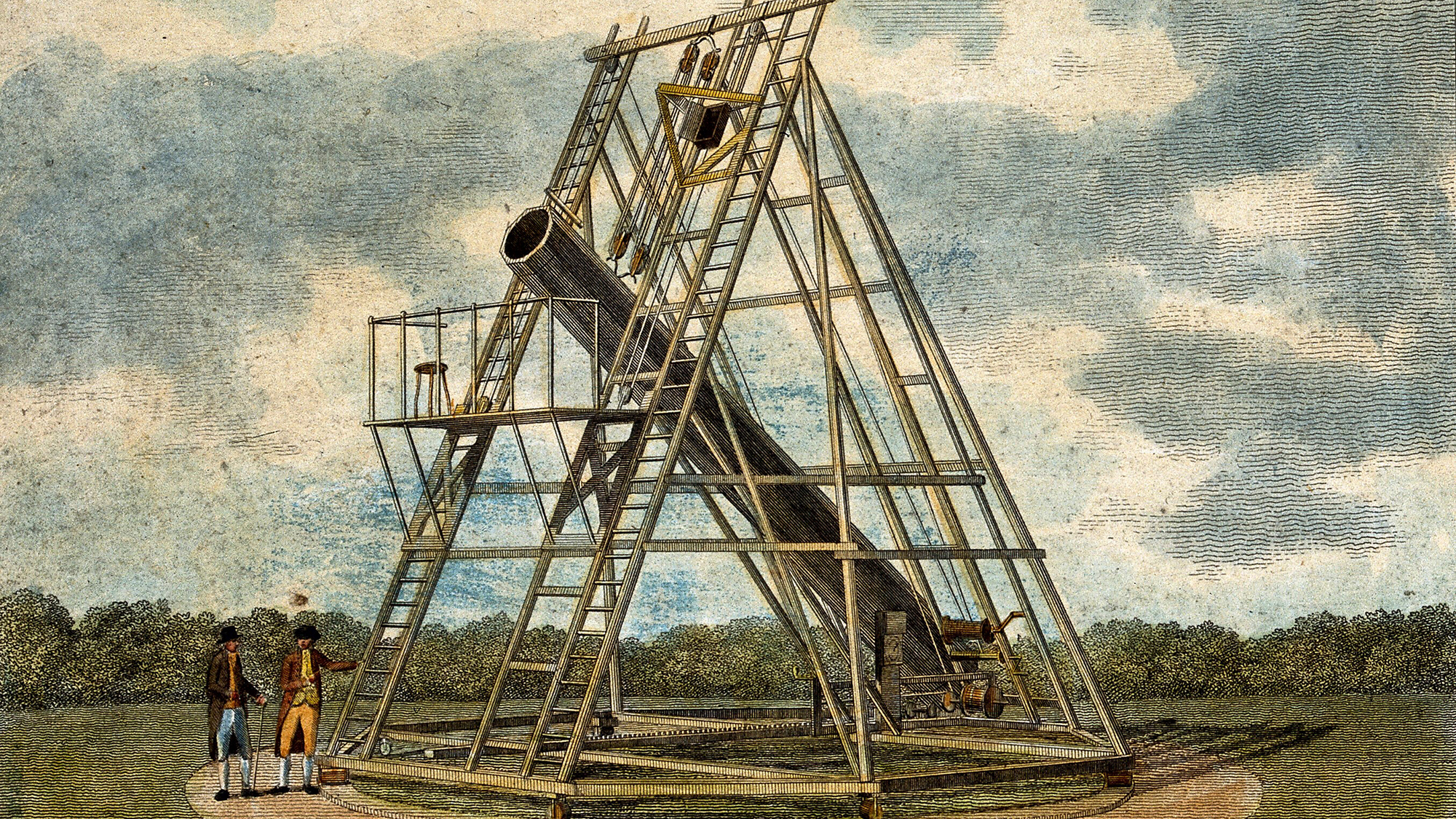
Astronomy: a 40-foot telescope constructed by William Herschel, in use outdoors. Coloured etching, 18–. Wellcome Collection. Public Domain Mark. Source: Wellcome Collection
The first telescopes, known as refracting telescopes, were built in the early 17th century by Dutch eyeglass makers. They employed a pair of lenses—one convex fitted at the end of the scope, and one concave for the eyepiece. For the most part, these scopes were used to survey land and for military exploits. Italian astronomer Galileo Galilei was among the first to point such spyglasses at the sky.
Johannes Kepler, a German astronomer, improved upon the convex-concave design with a pair of convex lenses. The advantage was a wider field of view and higher magnification, but the images appeared upside down. Still, telescope makers who implemented Kepler’s design were able to achieve 100 times magnification with telescopes as long as 150 feet. Such long tubes, however, did not fare well in wind and weather, making them somewhat ineffective.
Sir Isaac Newton offered an alternative design based on reflection, or curved mirrors, which captured more light and avoided the distorting prism effect that happens when light passes through a lens, known as chromatic aberration.
For more than two centuries, mirror size, material, and quality continued to increase—as did telescope sizes, until the space era when space-based telescopes, like Hubble and James Webb, eliminated the interference from Earth’s atmosphere. With James Webb, we’re able to peer farther than ever across the universe, spying some of the first galaxies to form after the Big Bang more than 13 billion years ago.
Today, NASA has multiple space-based telescope projects underway, including the Nancy Grace Roman telescope and Habitable Worlds observatory.
1609: Refracting telescopes
Inspired by Dutch and Danish telescope makers, Galileo built his own in 1609. His first telescope offered 3x magnification. Over the years, his design improved. His final telescope could magnify objects as much as 30 times.
1610: Moon Illustrations from Galileo’s own drawings in Sidereus Nuncius (The Starry Messenger)
Fortunately, Galileo was not only a gifted astronomer but also an accomplished artist, enabling him to capture detailed images of the cosmic objects he spied through his lens. This sketch of the Moon revealed never before seen—or contemplated—lunar mountains and craters.
1672: Sir Isaac Newton’s reflecting telescope
When light passes through glass, it is separated into color bands (ROYGBIV), which meant that refracting telescopes suffered from chromatic aberrations that affected image quality. Seeking to overcome the prism effect, Sir Isaac Newton built a reflecting telescope that used curved mirrors instead.
Laurent Cassegrain improved upon Newton’s design in 1672 by using a concave primary mirror and a convex secondary mirror to reflect light back through a hole in the primary mirror to the eyepiece, enabling a long focal length in a compact tube.
1789: Herschelian telescope
Sir William Herschel’s telescope was a reflecting design with a large primary mirror and an eyepiece positioned off-axis to avoid obstructing the light path. This allowed for larger mirrors and greater light-gathering power.
With one of his telescopes, Herschel spied a new planet, which he named Georgium Sidus for King George III. The planet was later named Uranus.
Herschel’s drawings of nebulae from “The Scientific Papers of Sir William Herschel” published in London in 1912 by the Royal Society and the Royal Astronomy Society.
1900: The Great Telescope of the Paris Exposition
This 57-meter reflecting telescope—more than half the length of a football field—was built by Paul Gautier for the 1900 Paris Exposition. It had a 1.25-meter diameter mirror.
1917: Hooker Telescope
Designed by George Ellery Hale, the Hooker telescope at Mount Wilson Observatory used a 100-inch diameter mirror, making it the largest telescope in the world at the time. It significantly advanced the study of galaxies and nebulae.
Edwin Hubble used the Hooker telescope in the 1920s and later, which paved the way for our understanding that the universe was much bigger than just our galaxy, and the Big Bang theory.
1990: Hubble Space Telescope
Built by NASA and the European Space Agency (ESA), the Hubble Space Telescope is a space-based reflecting telescope with a 2.4-meter diameter mirror. It operates in Earth’s orbit above the atmosphere. When it began operation, it offered unprecedented clarity and detail in its observations of the universe.
NASA expects the telescope to remain operational through the end of the 2020s.
2021: James Webb Space Telescope
A collaboration of NASA, ESA, and the Canadian Space Agency (CSA), the James Webb Space Telescope is an advanced space-based reflecting telescope with a 6.5-meter diameter segmented mirror.
It operates in the infrared spectrum, allowing it to observe distant galaxies, exoplanets, and other celestial phenomena with exceptional sensitivity.
The Webb telescope orbits the Sun near the second Sun-Earth Lagrange point (L2), one million miles from Earth.
>>> Read full article>>>
Copyright for syndicated content belongs to the linked Source : Popular Science – https://www.popsci.com/science/telescopes-history/